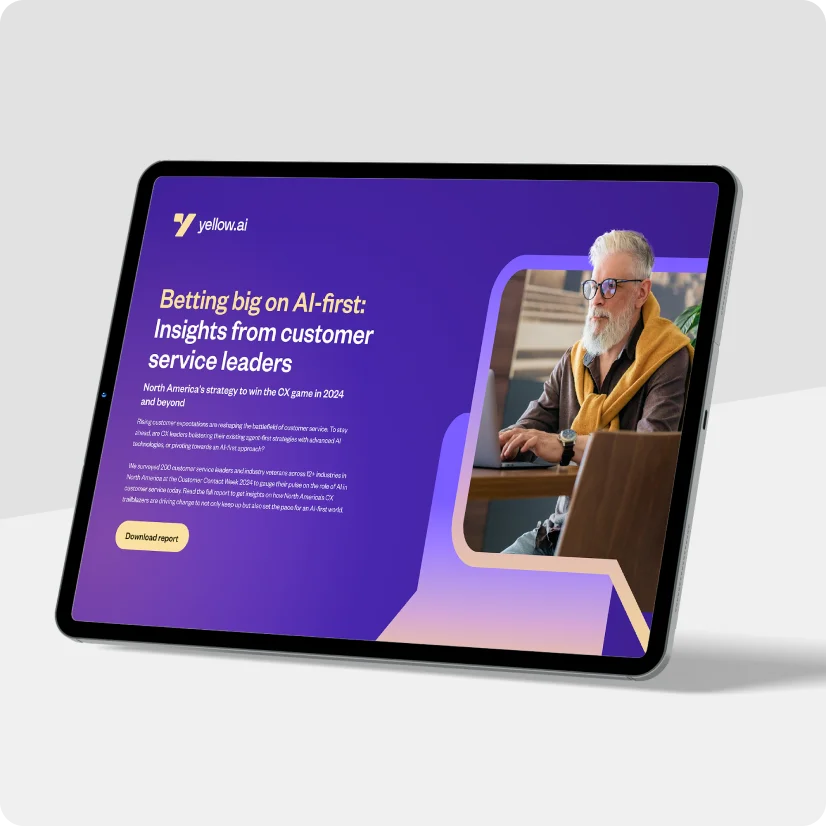Executive summary
Unlock the potential of your customer service team with this comprehensive guide. It spotlights the transformative power of targeted customer service training for employees. Explore the essentials of crafting an effective customer service training program, from selecting the right resources to integrating innovative training methods. With a focus on enhancing the customer experience and boosting team performance, this guide is your blueprint for nurturing a customer service team that exceeds customer expectations in today’s competitive landscape.
Introduction
Did you know that a mere 13% of customers find solutions through self-service channels alone? This statistic underscores the critical need for skilled customer service teams ready to tackle complex issues with ease and empathy. In an era where a single customer experience can echo across social media, the importance of equipping your team with the right training cannot be overstated. This blog is your guide to transforming customer service from a primary support function into a cornerstone of customer loyalty and business success.
Consider this: 88% of customers now place as much importance on the quality of service as they do on the products they purchase, as highlighted in Salesforce’s “State of the Connected Customer” report. This insight serves as a clarion call for businesses to prioritize exceptional customer service training, ensuring every interaction reflects the value and care customers seek. Through this exploration of cutting-edge training ideas and resources, we aim to inspire businesses to cultivate a culture of continuous learning and improvement. Here’s to building a customer service team that solves problems and creates lasting, positive impressions that keep customers coming back.
Related must-reads:
- Customer service automation – A full guide
- 10 Types of customer service you should know
- Customer service software: How to select the best one
- Good customer service: Ways to deliver [+10 Examples]
What is customer service training?
Customer service training is all about training your team to make every customer interaction count. It goes beyond just knowing the products and using the right software. This training involves skills like communication and empathy to enable your team to understand and meet customer needs. It is crucial in making customers feel valued and solving their problems effectively.
Customer service training is a crucial investment for any company aiming to stand out in today’s competitive landscape. It goes well beyond just resolving issues. It is about creating memorable experiences that customers want to share. Effective training equips your team to handle inquiries across various channels with confidence and finesse. It can turn challenges into opportunities for building stronger relationships. Whether it is through in-person workshops, online courses, or hands-on practice, the essence of customer service training lies in its ability to adapt and evolve with customer expectations. It ensures your team is always prepared to exceed them.
But here’s the real kicker: investing in this kind of training sends a powerful message. It tells your employees they are valued and gives your customers top-notch experiences that turn them into loyal advocates of your business. It is about building a workplace vibe where everyone is constantly learning and growing. It makes your business the place to be. Bottom line? Customer service training is more than just a good idea; it is the backbone of a thriving business.
Why does effective customer service training matter?
In today’s competitive market, customer service is not just a department—it is the very essence of your business’s success. Effective customer service training empowers businesses to elevate their customer interactions from satisfactory to exceptional. Let’s explore why investing in this training is indispensable.
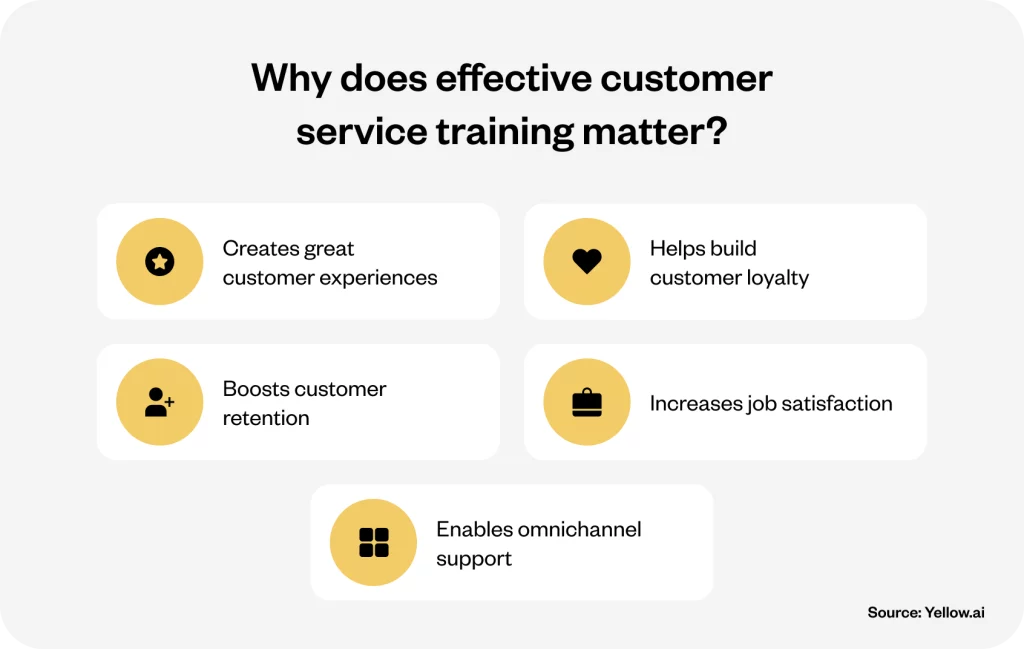
1. Creates great customer experiences
Imagine a customer, already frustrated with a problem, calls in. Instead of the expected hassle, they’re greeted with understanding and efficient help. It is not by chance. It is the result of targeted training that equips your team to turn potential negatives into positives. Such experiences don’t just resolve issues; they create stories your customers are eager to share. It will amplify your brand’s reputation by word of mouth.
Related read: How to improve customer experience? Full guide
2. Helps build customer loyalty
Loyalty is not bought; it is nurtured through consistent, positive interactions. Training enables your team to make every customer feel seen and valued. It can foster a sense of loyalty. For instance, when a service agent recalls a customer’s previous issue and follows up, it personalizes the experience. That makes the customer feel like part of your brand family.
3. Boosts customer retention
Consider the cost of winning a new customer versus keeping an existing one happy. Effective training provides your team with the skills to handle complaints in a way that can transform an unhappy customer into a brand advocate. A swift, empathetic resolution process demonstrates your commitment to customer satisfaction, encouraging them to stick around.
Related read: Customer retention: 15 strategies to improve CS
4. Increases job satisfaction
When your team knows they have the training and resources to handle any situation, their job satisfaction soars. This confidence leads to better customer interactions and a positive work environment. High morale among your staff translates into lower turnover rates and a stronger, more cohesive team.
5. Enables omnichannel support
Customers expect seamless help whether they reach out via phone, email, or social media. Training your team for omnichannel support ensures consistency across all platforms. A customer moving from chat to email without repeating their story is a small detail that significantly enhances the service experience.
Top 10 channels preferred by customers in customer support
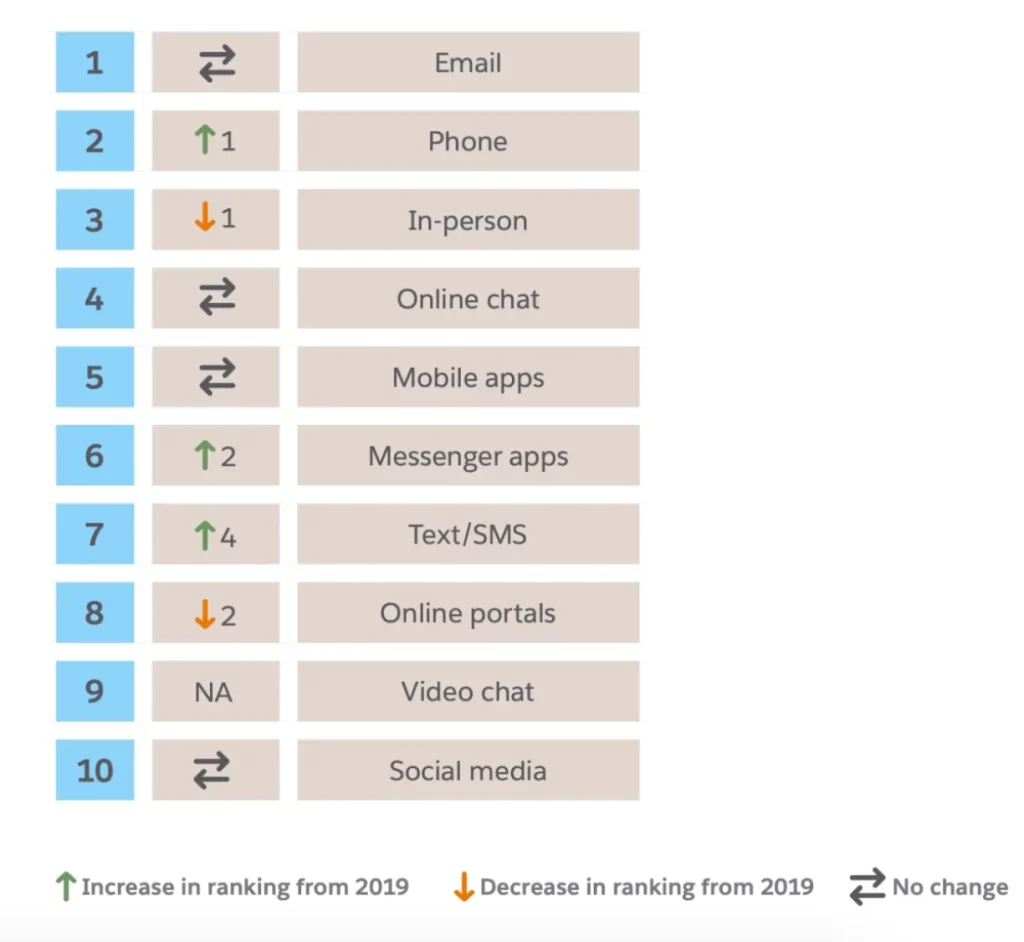
In short, effective customer service training is vital to crafting experiences that resonate, ensuring customer loyalty, and maintaining a satisfied, capable team. It is about transforming every customer interaction into an opportunity to demonstrate your business’s values and commitment to excellence.
Related read: Seamless omnichannel CX: Your step-by-step guide
Different types of customer service training
Customer service training isn’t a one-size-fits-all process. Different teams and different circumstances call for specialized training types, each designed to tackle unique challenges and leverage opportunities within customer interactions. Let’s dive into the spectrum of customer service training available, ensuring your team not only meets but exceeds customer expectations.
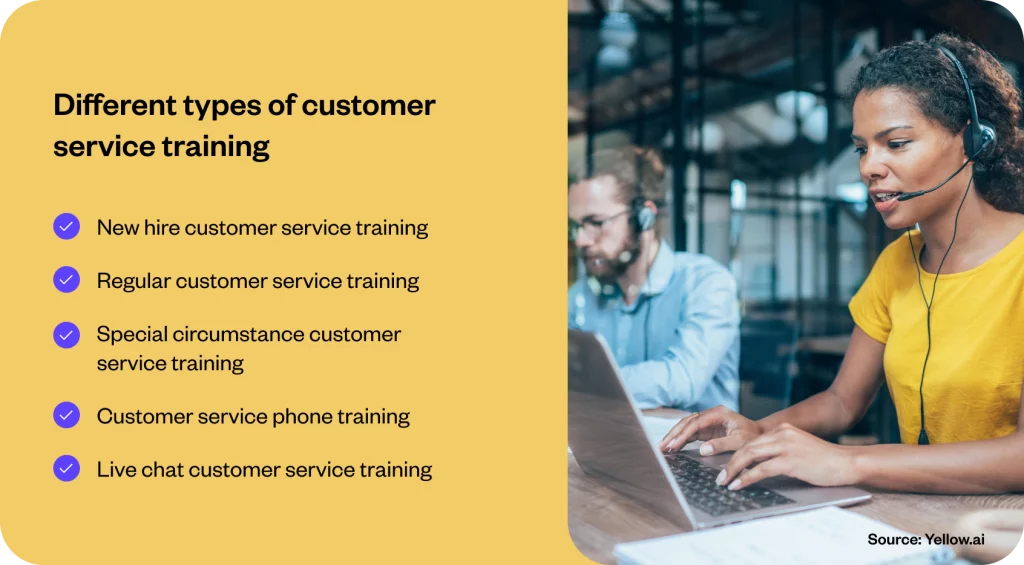
1. New hire customer service training
Welcoming new members into your customer service team is an opportunity to lay the foundation for your company’s values and expectations. This initial training phase is crucial, covering everything from product knowledge to the nuances of your brand’s communication style. Here, new hires learn to navigate customer service tools, understand your product or service inside out, and adopt the tone that your brand embodies in its customer interactions.
Key areas covered
- Brand values and vision: Instilling a sense of purpose and alignment with the company’s goals.
- Product mastery: Ensuring in-depth knowledge of the products or services to provide accurate support.
- Customer interaction protocols: Training on the do’s and don’ts of customer communication, focusing on tone, empathy, and problem-solving techniques.
Investing in comprehensive new hire training ensures your customer service team starts on the right foot, equipped to handle customer inquiries with confidence and empathy. This foundation is crucial for building a team that understands your products and also embodies your brand’s values in every interaction.
2. Regular customer service training
The learning journey does not stop after the onboarding process. Regular training sessions are vital to keep your team updated on product changes, improve service skills, and discuss new customer service strategies. This ongoing education ensures your team remains agile, informed, and ready to tackle any customer service challenge.
Key areas covered
- Skill refreshers: Revisiting core customer service skills and introducing advanced techniques.
- Product updates: Keeping the team up-to-date with the latest product developments or changes.
- Customer feedback insights: Learning from real customer interactions to improve service strategies.
Consistent training ensures your customer service team remains agile, informed, and ready to tackle any challenge. It reinforces a proactive approach to learning and development, which is crucial for staying ahead in the fast-paced world of customer service.
3. Special circumstance customer service training
Special circumstance training equips your team to handle atypical situations with grace—be it a product recall, a sudden service outage, or a global event impacting customer expectations. This training focuses on crisis management, communication under pressure, and maintaining customer trust during challenging times.
Key areas covered
- Crisis communication skills: Effective ways to convey empathy and solutions during crises.
- Adaptability and quick thinking: Strategies for rapid response and decision-making.
- Team coordination: Ensuring cohesive action and support among team members during emergencies.
Preparedness through special circumstance training empowers your team to transform potential negatives into positives, maintaining customer confidence even in turbulent times.
4. Customer service phone training
Despite the rise of digital communication, phone support remains a cornerstone of customer service. Phone training fine-tunes your team’s ability to connect with customers through voice alone. It’s about mastering the nuances of tone, pacing, and empathy to deliver service that resonates on a personal level.
Key areas covered
- Active listening: Skills to ensure customers feel heard and understood.
- Effective problem resolution: Strategies for navigating customer issues to a satisfactory conclusion.
- Empathy and reassurance: Techniques to convey genuine care and support.
Effective phone training enhances your team’s capacity to build rapport with customers. It can turn each call into an opportunity to strengthen brand loyalty.
5. Live chat customer service training
Live chat training hones the ability to provide swift, empathetic, and effective service in a text-based environment. It emphasizes the balance between prompt responses and maintaining a personalized touch.
Key areas covered
- Typing efficiency and clarity: Ensuring messages are both quick and precise.
- Digital etiquette: Best practices for online customer interactions.
- Multitasking mastery: Skills for managing multiple conversations without sacrificing quality.
Training for live chat equips your team to excel in the digital domain, ensuring customers receive the same level of care and attention online as they would over the phone or in person.
Related read: What is live chat? The definitive guide for businesses
How to hire the right people for your customer service team?
Selecting the right people for your customer service team is a game-changer. It is not just about ticking boxes for skills and experience. Businesses should find people who resonate with their brand and can genuinely connect with their customers. Here’s an appropriate approach to identifying the team that will define your customer service excellence.
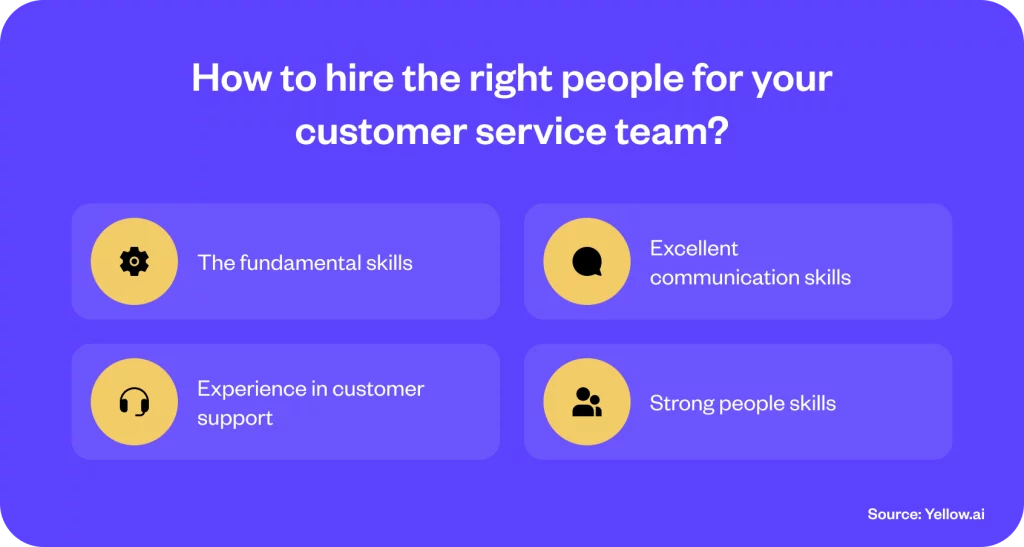
1. The fundamental skills
Start with the basics. What makes a candidate stand out isn’t always their resume but their eagerness to tailor their application to your needs. It shows they are not just looking for any job—they want this job. During interviews, assess their problem-solving skills. Present them with typical customer scenarios and see how they think on their feet. It tells you a lot about how they will handle real-life customer interactions.
Why does this matter? A team member who can quickly adapt and tackle issues head-on is invaluable. They’re the ones who can turn a potential service disaster into a win, making customers feel heard and helped. It’s this kind of proactive, thoughtful service that builds your reputation for customer care excellence.
2. Excellent communication skills
Effective communication is the cornerstone of outstanding customer service. Evaluate this through the interview process. If a candidate struggles to express themselves clearly or show empathy, they might not be the right fit. Try role-playing exercises to see how they handle customer queries. Can they explain your product simply and effectively? It is a strong indicator of their ability to communicate with customers in real situations.
The impact? A team skilled in clear, empathetic communication can resolve issues efficiently and also make every customer feel valued and understood. Imagine a customer calling in, frustrated and confused, and ending the call feeling relieved and satisfied. That’s the power of excellent communication.
3. Experience in customer support
Experience can be a bonus, but it is the quality of experience that truly counts. In interviews, dig into their customer service philosophy. How do they deal with challenging situations? What’s their most memorable customer service win? Their stories will give you insight into their approach to customer care and their potential fit with your team.
Bringing experienced customer service professionals on board means they can hit the ground running, bringing insights and best practices that enrich your team’s approach to service. Their seasoned perspective can elevate the customer experience from day one.
4. Strong people skills
Finally, strong interpersonal skills are non-negotiable. Customer service is a team sport. Pay attention to how candidates interact with others from the moment they walk in. Are they listeners? Do they ask insightful questions about team dynamics? It gives you a glimpse into how they’ll gel with your team and contribute to a positive work environment.
Why it’s crucial: A team that works well together provides seamless, unified customer service. It’s about more than just resolving tickets; it’s about creating a supportive and positive service culture. For instance, a team member who’s a natural at de-escalating tense situations not only benefits your customers but also helps maintain team harmony.
What should you include in a customer service training program?
Creating an impactful customer service training program is just like crafting a unique recipe that caters to the distinct palate of your business’s customer service ethos. It is about blending the essential soft and hard skills that equip your customer service representatives (CSRs) to deliver satisfactory and exceptional customer experiences. Here is how you can design a training program that encompasses all the necessary ingredients.
Related read: Customer service representative: Skills & Strategies
1. Soft skills for customer service reps
The heart of effective customer service lies in empathy and active listening. Training should emphasize understanding customer emotions and reading between the lines. Role-playing scenarios that cover a range of customer moods, from frustration to delight, can sharpen these skills. Trainees learn to tailor their responses to the customer’s emotional state. It transforms service interactions into positive experiences.
Imagine a scenario where a customer is upset over a delayed shipment. A trained CSR would acknowledge the customer’s disappointment, express genuine understanding, and provide a clear resolution path. This approach diffuses tension and often converts a potentially negative experience into a loyalty-building opportunity. Embedding this in training ensures CSRs are equipped to handle emotional nuances, fostering a customer-centric culture.
2. Hard skills for customer service reps
In-depth knowledge of your products or services is non-negotiable. Training must include comprehensive product education, using a combination of hands-on experience, detailed product guides, and FAQs. Additionally, CSRs need to be fluent in using customer service software tools, from CRM platforms to ticketing systems. It will enable them to retrieve and record information swiftly and accurately.
Consider a customer calling in with a complex technical issue. A well-trained CSR, armed with profound product knowledge and proficient in navigating support tools, can quickly identify the problem and guide the customer through the solution. This efficiency resolves issues faster and significantly enhances customer satisfaction and trust in your brand.
How to create a customer service training program?
Creating a customer service training program is a strategic process that ensures your customer service team meets and exceeds customer expectations consistently. Here’s how to establish a program that fosters excellence in customer service:
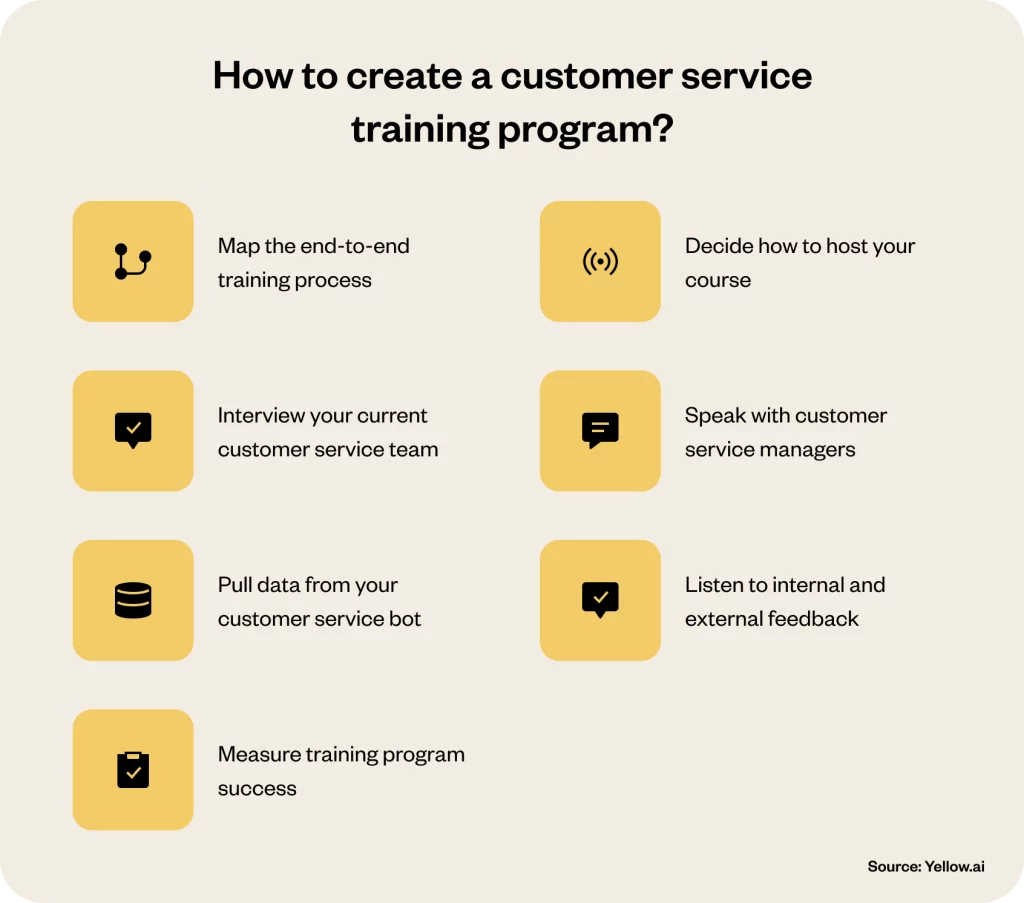
1. Map the end-to-end training process
Begin by mapping out the entire customer service journey, highlighting every touchpoint your team has with customers. This comprehensive mapping should cover everything from initial contact through various service channels to the resolution of issues and follow-up interactions. By understanding the full scope of customer interactions, you can identify key areas where training is most needed. It will ensure your team is well-prepared to deliver exceptional service at every stage.
Important tips
- Use real customer interaction scenarios to illustrate each touchpoint.
- Incorporate role-play exercises that mimic these touchpoints in your training sessions.
2. Decide how to host your course
Choose a training format that best suits your team’s needs and learning preferences. Whether it’s in-person workshops, online courses, or a hybrid approach, the method you select should facilitate interactive learning and encourage active participation. Consider using a Learning Management System (LMS) to host your online training modules, allowing for easy access to, tracking of, and updating of course materials.
Important tips
- Incorporate a mix of visual, auditory, and hands-on learning activities to cater to different learning styles.
- Ensure online platforms are user-friendly and accessible from multiple devices.
3. Interview your current customer service team
Gain insights directly from your front-line staff about the challenges they face and the skills they find most valuable in their roles. This input is crucial for tailoring your training program to address real-world issues and empower your team with practical skills. Use this feedback to update and refine your training materials continually.
Important tips
- Create a feedback loop where team members can regularly contribute suggestions for training improvement.
- Highlight success stories and best practices shared by experienced team members in your training content.
4. Speak with customer service managers
Managers have a unique perspective on the team’s overall performance and the common challenges that arise. Their insights can help identify gaps in current training programs and pinpoint advanced skills that need to be developed. Incorporating managerial feedback ensures that your training program aligns with both strategic objectives and operational needs.
Important tips
- Regularly review training effectiveness with managers to ensure it meets evolving business needs.
- Develop leadership training modules for managers to help them support their teams effectively.
5. Pull data from your customer service bot
Analyze interactions with your customer service bot to identify frequently asked questions and common issues customers face. This data can help prioritize training topics and ensure that your team is prepared to handle the most common customer inquiries efficiently.
Important tips
- Use analytics to track improvements in handling bot-escalated issues post-training.
- Continuously update the bot’s knowledge base based on insights gained from customer interactions.
6. Listen to internal and external feedback
Incorporate feedback from both team members and customers to make informed improvements to your training program. Customer feedback, in particular, can highlight areas where your service might be falling short and provide a direct link to the training needs of your team.
Important tips
- Implement regular customer satisfaction surveys to gauge the impact of training on service quality.
- Encourage a culture of continuous improvement by rewarding teams for implementing feedback effectively.
7. Measure training program success
Establish clear metrics to evaluate the effectiveness of your training program. These could include customer satisfaction scores, resolution times, and the number of issues resolved on the first contact. Regularly reviewing these metrics will help you understand the impact of training on your customer service quality and identify areas for further development.
Important tips
- Set baseline metrics before training begins to measure improvement over time.
- Adjust training content and methods based on performance trends and feedback.
How to onboard agents to customer service training programs?
Onboarding new agents into your customer service training program is a crucial step toward building a strong, effective team. Here’s how you can ensure a smooth transition and set them up for success:
Related read: AI Agents: Types, Benefits and Examples
1. Start small and gradually increase complexity:
Begin the onboarding process with basic tasks and information to prevent overwhelming your new hires. Initially, focus on a single support channel or a specific type of customer inquiry. This approach allows agents to build confidence and competence before tackling more complex issues. As they progress, gradually introduce them to the broader aspects of their role.
2. Train directly in the support channels an agent will use:
Practical, hands-on training in the actual support channels agents will use is vital. Whether it’s email, chat, or phone support, ensure that agents receive specific training tailored to each channel. This direct training helps them understand the nuances and challenges unique to each mode of communication.
3. Assign mentors to new hires:
Pairing a new agent with an experienced mentor can significantly ease their transition into the role. Mentors can offer guidance, answer questions, and provide support as the new agent navigates their first few months. Consider assigning mentors from different teams to encourage broader integration within the company.
4. Make sure new agents learn the tools:
Familiarity with customer service tools is essential for efficiency and effectiveness. Ensure new agents receive comprehensive training on your CRM software, ticketing systems, and any other tools they’ll use daily. This knowledge is crucial for managing customer interactions smoothly and efficiently.
5. Teach them about your product and services:
In-depth product knowledge is non-negotiable for customer service agents. Give them opportunities to use your products or services firsthand and encourage exploration of your knowledge base. Regular assessments or quizzes can help reinforce their understanding and ensure they’re equipped to help customers effectively.
6. Establish a “Learn on the Go” culture:
Encourage a culture of continuous learning and improvement. Agents should view every customer interaction as an opportunity to enhance their skills and knowledge. Promote an environment where asking questions and seeking help is encouraged, fostering a team dynamic that values growth and support.
7. Use an agent-assist bot for on-the-job training:
Bringing a bot into the mix for on-the-job training can be a game-changer, especially for newbies. Think of it as having a virtual mentor who is always on call, ready to nudge your agents in the right direction with quick tips, responses, or pointers to the info they need. It is like the training wheels for customer service – there when you need it but unobtrusive. In a remote setting, where a quick shoulder tap isn’t an option, this becomes an invaluable tool for immediate support.
How Yellow.ai can revolutionize your customer service experience
As businesses strive for excellence in customer service, the integration of advanced AI solutions becomes essential. Yellow.ai is at the forefront of this revolution, offering AI-powered solutions designed to elevate customer service to new heights. Here’s how Yellow.ai can transform your customer service landscape:
– Natural Language Processing (NLP): Yellow.ai’s tools are equipped with cutting-edge NLP capabilities, allowing them to understand and interpret customer queries in a human-like manner. It ensures that interactions are smooth, natural, and efficient, significantly enhancing the customer experience.
– No-code bot builders: Empower your team to create and deploy AI chatbots without the need for extensive coding knowledge. Yellow.ai’s intuitive no-code platform makes it easy to tailor customer service solutions to your specific needs, ensuring flexibility and adaptability.
– Multilingual support: Break language barriers with Yellow.ai’s multilingual platforms, which are capable of interacting with customers in their native language. This global reach ensures that your business can deliver exceptional service to a diverse customer base.
– Learning and Prediction (LLP): Yellow.ai tools continuously learn from interactions, improving their responses and predictions over time. This self-optimizing technology means your customer service improves with every interaction.
– Seamless integration: Yellow.ai’s solutions integrate smoothly with your existing CRM, ensuring that customer interactions are informed by the latest data and insights. This integration streamlines operations and enhances the effectiveness of your customer service team.
– Analytics and insights: Gain deep insights into customer preferences, behaviors, and feedback. Yellow.ai’s analytics tools help you understand your service performance, identify areas for improvement, and make data-driven decisions to enhance customer satisfaction.
Ready to elevate your customer service with AI? Book a demo with Yellow.ai today and discover the difference intelligent automation can make to your business.
The final thoughts
The customer service landscape is rapidly evolving in today’s digital age. Businesses that leverage innovative technologies like Yellow.ai set themselves apart and also create a customer service experience that is efficient and profoundly personalized. It is about harnessing the power of AI to exceed the expectations of the modern consumer. Investing in AI-driven customer service solutions is a step towards technological advancement and a commitment to your customers and the quality of support you wish to provide. As we look to the future, the integration of AI in customer service is the pathway to excellence.
Frequently asked questions (FAQs)
What are the key components of effective customer service training?
Effective customer service training encompasses a blend of soft skills development, such as empathy and communication, and hard skills, including product knowledge and tool proficiency. A comprehensive approach addresses the diverse aspects of customer interactions, ensuring agents are well-prepared to meet customer needs.
How often should customer service training be conducted?
Customer service training should be an ongoing process, with initial training for new hires followed by regular updates and refreshers. It ensures that customer service representatives stay current with product developments, service protocols, and evolving customer expectations.
What are the best methods for delivering customer service training?
The most effective methods combine theoretical learning with practical application, including workshops, role-playing, e-learning modules, and on-the-job mentoring. This mix caters to different learning styles and ensures comprehensive skill development.
How can you measure the success of customer service training?
Success can be measured through customer satisfaction scores, resolution times, first-contact resolution rates, and employee feedback. Regular assessment helps identify areas for improvement and the impact of training on service quality.
What are the benefits of investing in customer service training?
Benefits include improved customer satisfaction, increased loyalty, enhanced brand reputation, higher employee engagement, and reduced turnover. Training equips agents to handle inquiries effectively, fostering positive customer relationships.
Can customer service training improve employee retention?
Yes, effective training programs contribute to higher job satisfaction by empowering employees with the skills and confidence needed to excel in their roles. It can lead to increased engagement and lower turnover rates.
What are common challenges in customer service training?
Challenges include keeping training materials up-to-date, addressing diverse learning styles, measuring training effectiveness, and ensuring the practical application of learned skills. Overcoming these challenges requires a flexible, comprehensive approach to training design and delivery.
























